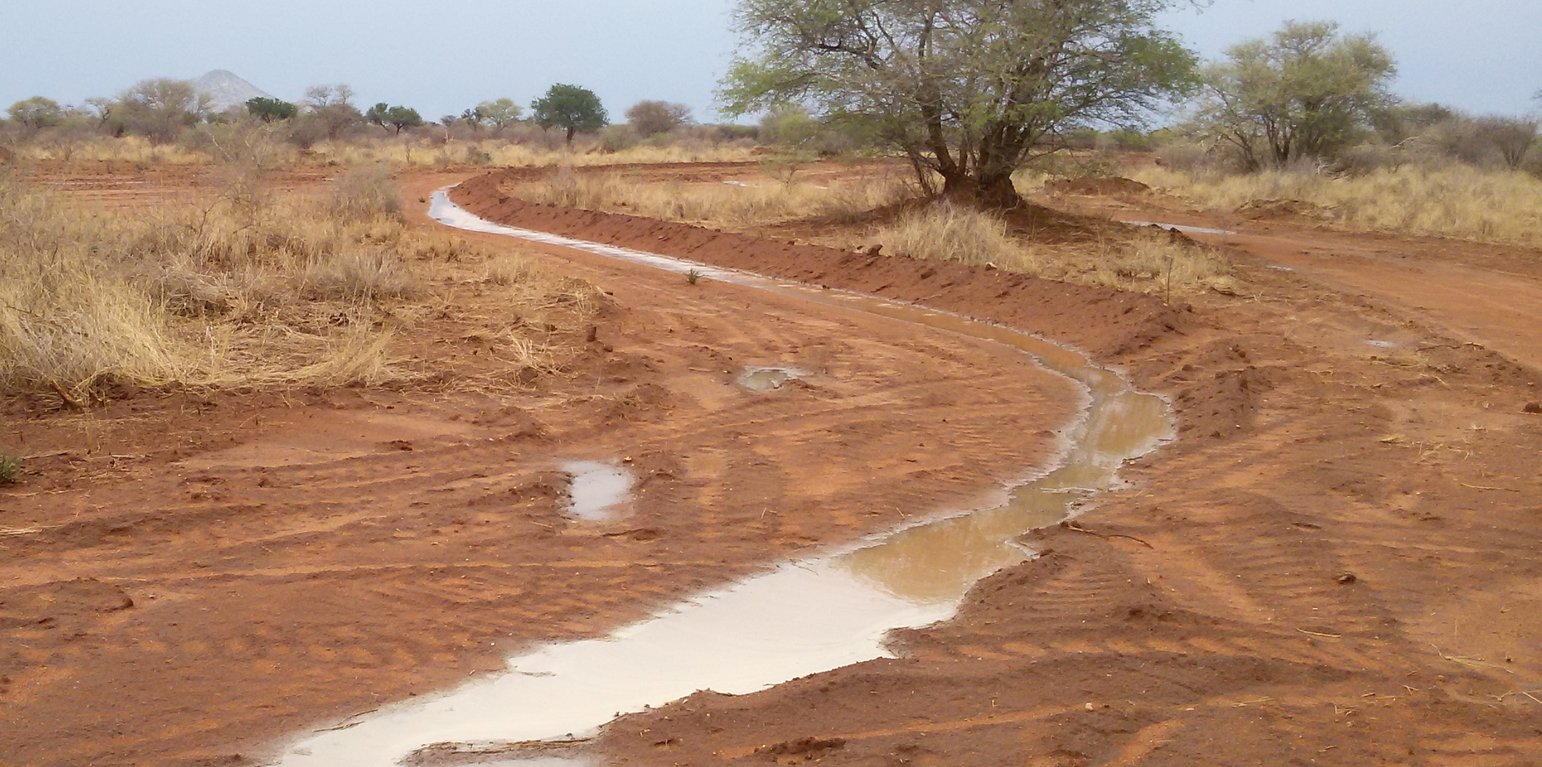



The technology can be applied in rangeland: (a) where rainfall runoff occurs, (b) where the soil is deep enough to dig contour ditches and construct ponding banks, (c) where there is a low slope over a wide enough area for safe discharge of overflow during intense rain, (d) where valuable plants can benefit from the extra infiltrated rainwater, (e) where the costs of earthmoving can be rapidly recovered through sale of extra production and, very importantly, (f) where the root causes of rangeland degradation have been addressed, usually through management of grazing and fires.
In the appropriate area, contour lines are marked out by laser or dumpy level - or mapped by drone. Where bush is dense, it may be necessary to clear narrow contour strips, leaving larger trees in place. Ditches are dug up to 50cm deep by mechanised grader or backhoe (a digger attached to a tractor), or manually by pick and spade. The soil should first ideally be ripped where the bund is formed, to ensure a firm foundation. To stabilise the bund, it should be compacted, and creeping (stoloniferous) herbaceous plants encouraged to colonise it. When ditches are full, water is discharged through spillways within the bund. These spillways are formed by lowering the bund to about half its height (i.e. 25 cm) for a distance of 10 metres. Water overtops the spillways and flows across the soil surface to the next bund in the sequence. Spillways are set near alternating ends of shorter ditches for water to zigzag its way down through the landscape, but along longer ditches the spillways are set approximately 200 metres apart. There are other configurations, including one where excess runoff flows around the end of the bund and along another channel constructed immediately below the bund. It can then spill out of this channel, evenly over the soil surface below. Where bunds meet roads or tracks, a hump is made in the road to prevent water crossing and causing damage but instead channelling the road runoff into contour ditches.
Since the channel is never exactly on the contour, water starts to flow over the lowest section. This results in self-reinforcement over time because herbaceous plants establish more densely at that point, resulting in more sediment being trapped there. To avoid spillage around each end of the ditch, the bund is shaped to form a short upslope wingwall. Organic material can be placed in the ditch, or in larger sediment traps within the ditch, to improve nutrient cycling.
Infiltration ditches were constructed at vertical intervals of 0.5 m on a 30 ha, densely bushed portion of the Middleplaats farm. Trees were planted below the ditches to grow into a “fruitful landscape”. Species included broad canopy trees such as Faidherbia albida and Acacia erioloba, shorter thornless trees for “chop and drop” mulching, such as Peltophorum africanum and Bolusanthus speciosus, and fruit bearing trees, such as Sclerocarya birrea and Berchemia discolor, or trees with edible leaves, such as Moringa oleifera. Tree seedlings were raised in a nursery. Fencing around the 30ha had to be strengthened to protect the seedlings from oryx. It was also necessary to water the seedlings for one to two years until well established. Ponded water encourages natural growth of herbaceous plants, and to encourage this some grasses were transplanted there.
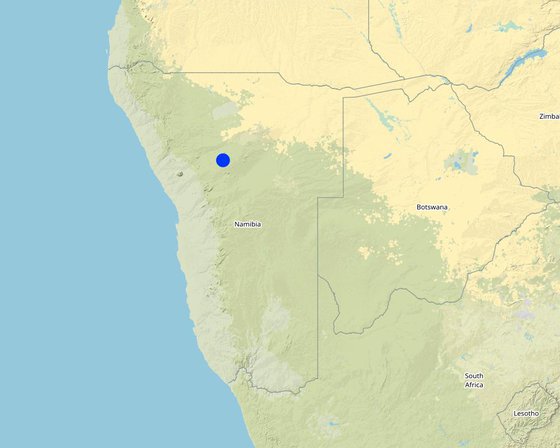
สถานที่: Otjozondjupa and Khomas Retions, นามิเบีย
ตำนวนการวิเคราะห์เทคโนโลยี: 2-10 แห่ง
การเผยแพร่ของเทคโนโลยี: กระจายไปอย่างสม่ำเสมอในพื้นที่ (approx. 0.1-1 ตร.กม.)
In a permanently protected area?:
วันที่ในการดำเนินการ: 2014
ประเภทของการแนะนำ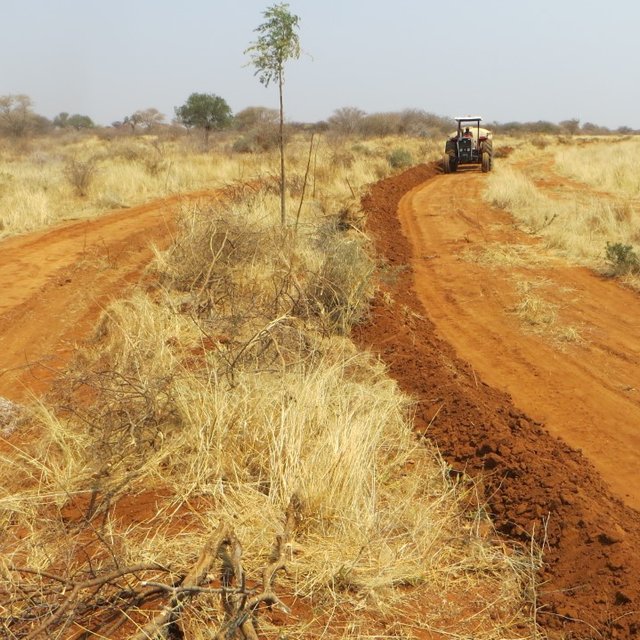
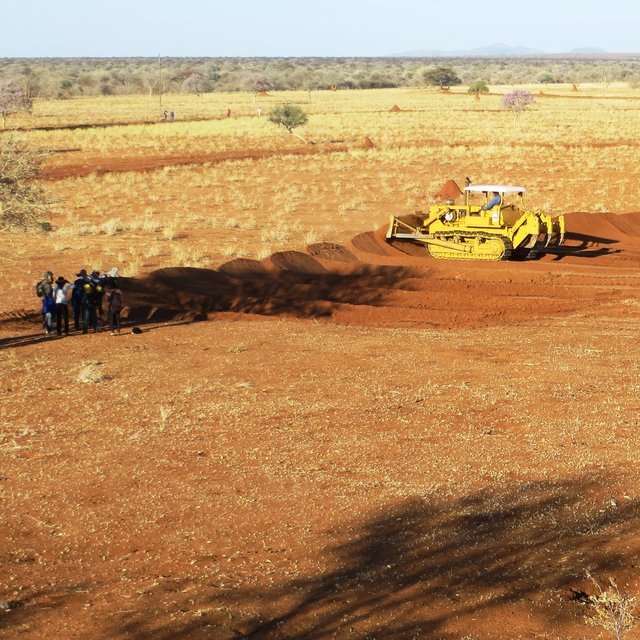






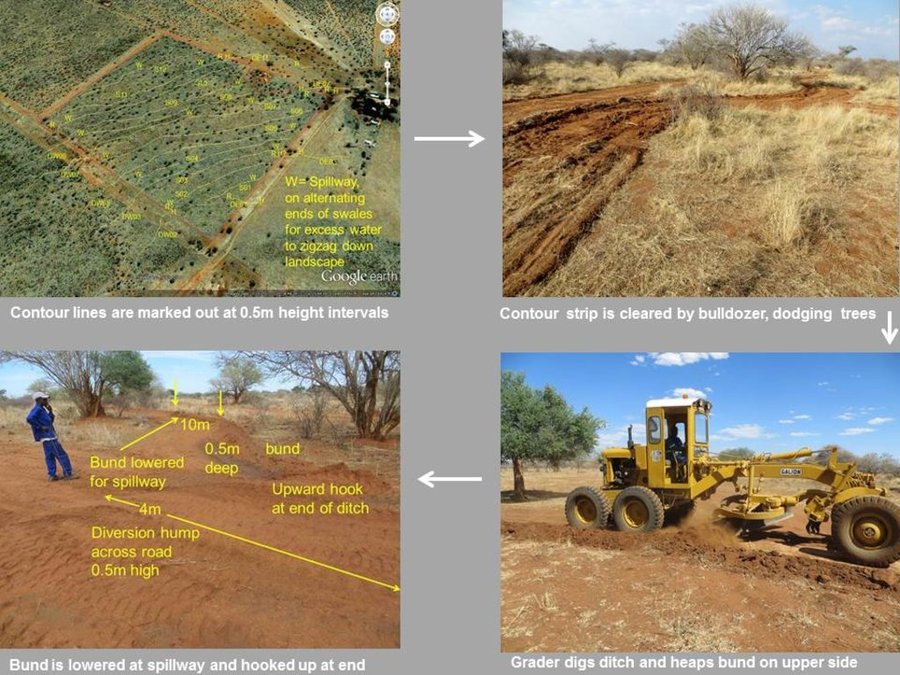
| ปัจจัยนำเข้า | หน่วย | ปริมาณ | ค่าใช้จ่ายต่อหน่วย (NAD) | ค่าใช้จ่ายทั้งหมดต่อปัจจัยนำเข้า (NAD) | %ของค่าใช้จ่ายที่ก่อให้เกิดขึ้นโดยผู้ใช้ที่ดิน |
| แรงงาน | |||||
| Marking of contour lines | Person days | 6.0 | 72.0 | 432.0 | 100.0 |
| Raising tree seedlings in nursery | Person days | 20.0 | 72.0 | 1440.0 | 100.0 |
| Planting tree seedlings below ditches | Person days | 10.0 | 72.0 | 720.0 | 100.0 |
| Watering every 10 days in first year, except after rain | Person days | 150.0 | 72.0 | 10800.0 | 100.0 |
| อุปกรณ์ | |||||
| Strengthening fence to exclude oryx (Labour) | Person days | 100.0 | 72.0 | 7200.0 | 100.0 |
| Bulldozer to clear strips and rip | Bulldozer hours | 89.0 | 850.0 | 75650.0 | 100.0 |
| Grader to dig ditches and heap bunds | Grader hours | 35.0 | 650.0 | 22750.0 | 100.0 |
| Diesel for bulldozer and grader | Litres | 1000.0 | 12.0 | 12000.0 | 100.0 |
| Tractor & 7000 lt water trailer every 10 days in first year, except after rain | Tractor days | 30.0 | 1250.0 | 37500.0 | 100.0 |
| วัสดุด้านพืช | |||||
| 500 Plastic bags / seeds with soil to raise seedllngs | Filled growing bags | 500.0 | 4.0 | 2000.0 | 100.0 |
| วัสดุสำหรับก่อสร้าง | |||||
| Fencing wire and posts to strengthen fence around fruitful landscape | km of fencing | 3.0 | 2200.0 | 6600.0 | 100.0 |
| ค่าใช้จ่ายทั้งหมดของการจัดตั้งเทคโนโลยี | 177'092.0 | ||||
| Total costs for establishment of the Technology in USD | 177'092.0 | ||||
| ปัจจัยนำเข้า | หน่วย | ปริมาณ | ค่าใช้จ่ายต่อหน่วย (NAD) | ค่าใช้จ่ายทั้งหมดต่อปัจจัยนำเข้า (NAD) | %ของค่าใช้จ่ายที่ก่อให้เกิดขึ้นโดยผู้ใช้ที่ดิน |
| อุปกรณ์ | |||||
| Grader cost to maintain the swales every 3 – 4 years | Grader hours | 8.0 | 700.0 | 5600.0 | 100.0 |
| ค่าใช้จ่ายทั้งหมดของการบำรุงรักษาสภาพเทคโนโลยี | 5'600.0 | ||||
| Total costs for maintenance of the Technology in USD | 5'600.0 | ||||
Mainly Moringa oleifera
Moringa leaves
Moringa heavily browsed
Still saplings
Moringa leaves and fruits of other species could be harvested
Livestock need less water after feeding on lush forage
High initial cost of earthmoving
Potential from Moringa
To water saplings
Nutritious Moringa leaves may be added to diets
If nutritious Moringa leaves are eaten
Learning from action research
Slowed, spread and infiltrated by ditches and ponds
From improved infiltration
Near ditches and banks
In ditches and ponds
Below ditches and ponds
Through tree and grass roots
In ditches and ponds
In ditches and ponds
In ditches and ponds
Along ditches and ponds
Along ditches and ponds
Along ditches and ponds, due to increased grass